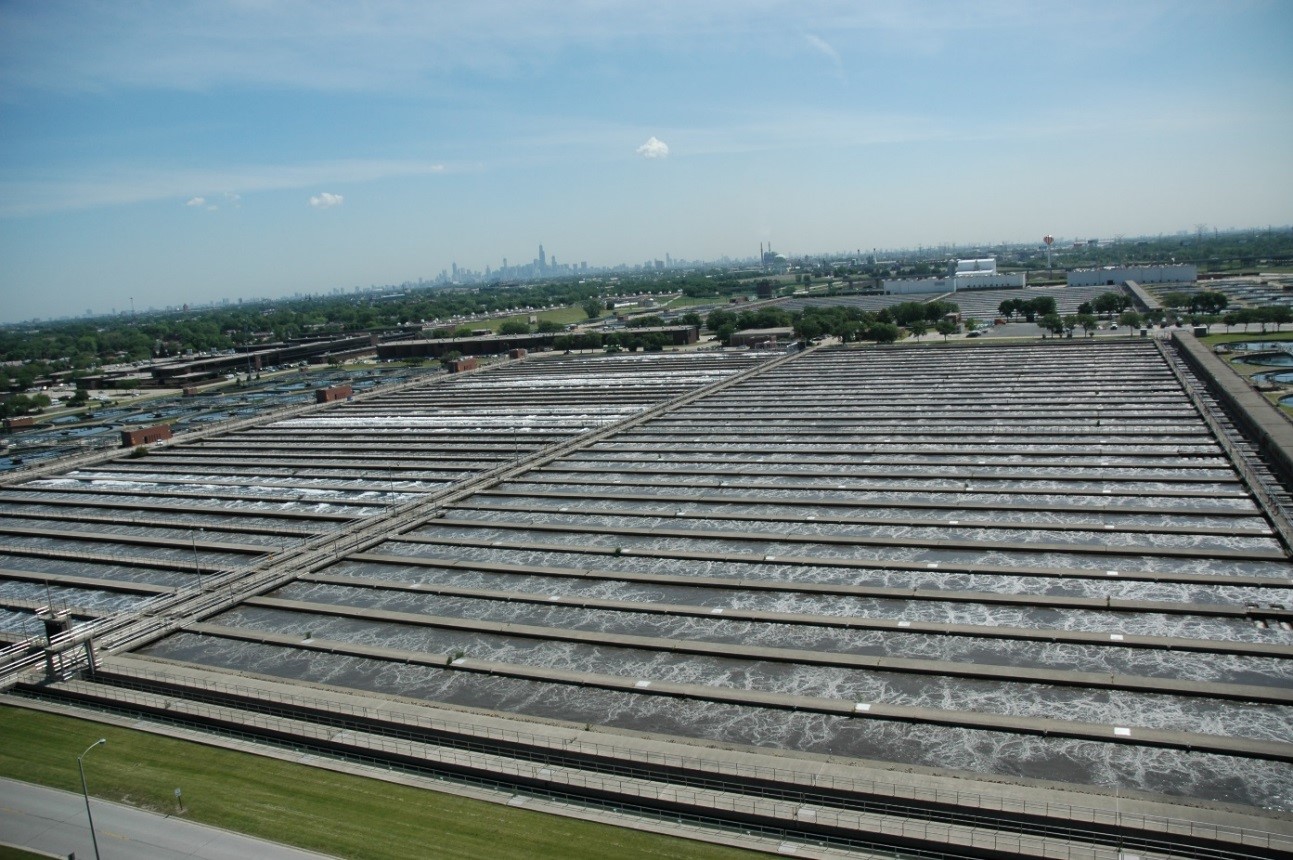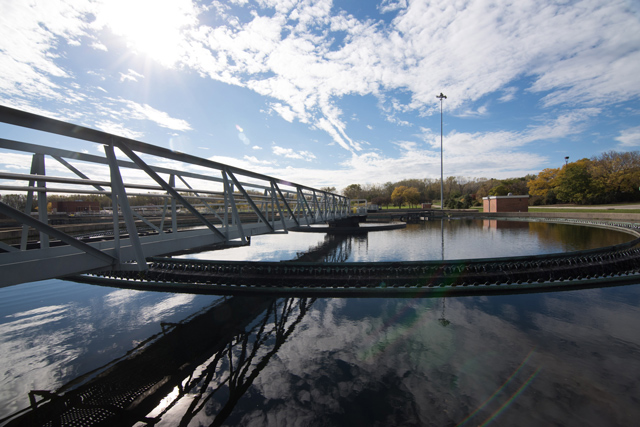
The Stickney Water Reclamation Plant (SWRP) is the largest wastewater treatment facility in the world. SWRP serves 2.3 million people in a 260 square mile area including the central part of Chicago and 46 suburban communities. Encompassing 413 acres, the WRP is home to nearly 400 employees, who oversee the treatment of up to 1 million gallons of water per minute, similar to pumping two Olympic size swimming pools in one minute. SWRP cleans an average of 700 million gallons of water per day and has the capacity to treat up to 1.44 billion gallons per day. SWRP consists of two plants; the west side portion of the plant was placed into service in 1930 and the southwest portion of the plant was placed into service in 1939.
Wastewater entering SWRP passes through coarse screens to filter out large debris, and is then pumped up from sewer level to flow by gravity throughout the treatment plant. Aerated grit tanks and settling tanks use physical and mechanical means to remove fats and oils and to separate solids from the water. The separated solids are pumped away to undergo their own treatment process and eventually become biosolids, a sustainable alternative to chemical fertilizers. In secondary treatment, a community of microorganisms help remove organic material from the wastewater. The microbes need oxygen to thrive, so air is pumped through the water in secondary aeration tanks. Next, the water enters the final settling tanks where remaining solids settle to the bottom and clean water flows out the top. The clean water is released from the SWRP into the Chicago Sanitary and Ship Canal. The whole process of converting raw sewage into clean water takes about 12 hours from the time it enters the plant to being processed, cleaned and released.
Solids removed during the process are sent to temperature-controlled digesters at SWRP that break them down in a process similar to composting that converts nutrients into forms that kill pathogens and provide beneficial use to plants. The solids are then dewatered in a centrifuge and air-dried at the nearby Lawndale Avenue Solids Management Area, resulting in biosolids that look and feel like dark, fine-textured topsoil. Composted with woodchips, the biosolids resemble commercial composts sold in retail stores but are richer in plant nutrients and perform better as a growing medium than commercial compost and fertilizer. Both the air-dried and composted biosolids could be used almost anywhere topsoil and chemical fertilizers are used. Some examples include golf courses, athletic fields, parks and other recreational areas, agricultural fields, and for restoration of brownfields and other disturbed lands. Biosolids are one of the many valuable resources recovered during the water treatment process.
In 2016, the MWRD unveiled the largest nutrient recovery facility in the world at SWRP. Phosphorus and nitrogen will be recovered to create a high value fertilizer with a process that is both economically and environmentally viable. By removing phosphorus from where it shouldn’t be—in the water—and returning it to where it should be, available to farmers, this facility represents a significant shift in the wastewater industry from treatment to recovery for reuse. Phosphorus is a non-renewable resource essential for life and is estimated to be gone from reserves within 100 years. Most of it is sourced from rock mines and must be transported considerable distances. Similar to nitrogen, excess phosphorus discharged to waterways can contribute to water quality problems. The MWRD partnered with Black & Veatch and Ostara to implement the advanced nutrient recovery technology that also protects waterways downstream from harmful algae blooms that come as a result of excess phosphorus. The Stickney phosphorus recovery facility will have the potential to recover between 1.9 and 2.4 million pounds per year of usable phosphorus to the economy in a high quality, slow-release form, which can be sold in stores and used in environmentally-friendly fertilizers. To read more about the new nutrient recovery facility at Stickney WRP, visit here.
SWRP is also undergoing various construction upgrades, including the transformation of 108 Imhoff tanks to nine 160-foot diameter primary settling tanks on the west side of SWRP and six 132-foot long aerated grit tanks, associated support facilities, service tunnels and conduits and modifications to the existing Monitoring & Research building. The new tanks provide more modern and effective treatment equipment that is less labor intensive than the previous tanks that have been in service since 1930. A significant increase in digester gas production will result from the project, allowing the MWRD to meet its goal of energy neutrality by 2023. The MWRD recently completed the construction of a gravity thickening facility that that consists of eight 80-foot diameter tanks and replacement of several centrifuges that will improve the thickening process by utilizing the most effective and efficient methods.
To learn more about Stickney WRP, visit here.

| National Association of Clean Water Agencies | |
| 2018 | Silver Award for 99.83% Compliance with National Pollutant Discharge Elimination System Effluent Standards. |
| 2017 | Silver Award for 99.94% Compliance with National Pollutant Discharge Elimination System Effluent Standards. |
| 2016 | Silver Award for 99.77% Compliance with National Pollutant Discharge Elimination System Effluent Standards. |
| 2015 | Gold Award for 100% Compliance with National Pollutant Discharge Elimination System Effluent Standards. |
| 2014 | Gold Award for 100% Compliance with National Pollutant Discharge Elimination System Effluent Standards. |
| 2013 | Silver Award for 99.7% Compliance with National Pollutant Discharge Elimination System Effluent Standards. |
| 2012 | Platinum Award for 100% Compliance with National Pollutant Discharge Elimination System Effluent Standards. |
| 2011 | Platinum Award for 100% Compliance with National Pollutant Discharge Elimination System Effluent Standards. |
| 2010 | Platinum Award for 100% Compliance with National Pollutant Discharge Elimination System Effluent Standards. |
| 2009 | Platinum Award for 100% Compliance with National Pollutant Discharge Elimination System Effluent Standards. |
| 2008 | Platinum Award for 100% Compliance with National Pollutant Discharge Elimination System Effluent Standards. |
| 2007 | Platinum Award for 100% Compliance with National Pollutant Discharge Elimination System Effluent Standards. |
| 1993 | Outstanding Operations Award for Sidestream Pool Aeration Stations. |